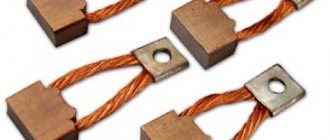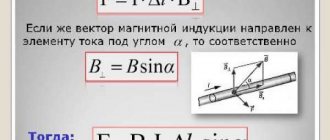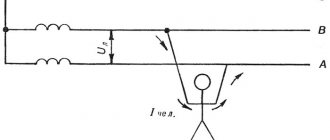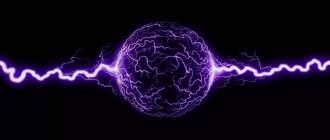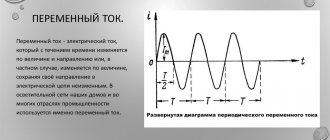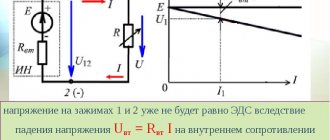4.3
Average rating: 4.3
Total ratings received: 190.
4.3
Average rating: 4.3
Total ratings received: 190.
Permanent magnets are bodies that can retain the ability to attract metal objects for a long time. What underlies this amazing property, how does a magnetic field arise, what substances can have such properties? Let's try to figure it out.
From the history of magnetism
In the VI century. BC. In ancient China, a mineral (rock) was discovered that attracted iron objects. The Chinese gave it the name “chu-shi”, which translates as “loving stone.” “Loving” - in the sense of attracting.
The word “magnet” was introduced into use by the ancient Greeks in the 5th century. BC. There is a legend that the first samples of these unusual “black stones” were found near the city of Magnesu, where deposits of magnetite were discovered. Magnet is translated as “stone from Magnesia”.
Magnetite is a black iron ore mineral, iron oxide Fe3O4, which has natural magnetic properties.
Magnetic effect of electric current: examples
In technological processes and everyday life, the magnetic properties of current are used in dozens of cases:
- Separator purposes are the purification of substances, such as food, from metal inclusions. Magnets remove metals from bulk materials: steel, iron, cast iron, and their alloys.
- Devices for separating charged particles.
- Magnetization of liquids and aqueous solutions.
- Cranes for loading, unloading, sorting metals. At the operator’s command, an electric current is passed through a strong electromagnet, which turns on/off the magnetic field, attracting or releasing scrap metal at the right moments.
- Control of microorganisms by influencing them with field formations.
- Electric motors - the operating principle is based on electromagnetic induction - the conversion of electrical energy into mechanical energy.
- A generator is a device for converting energy from one type to another.
- Magnetic plates that fix workpieces processed on grinding machines.
- Transport – magnetic locks, sensors.
- Medicine: magnetic resonance imaging.
- Actuating devices: switches, switches, valves.
- Computer equipment: hard drives, speakers.
The Earth's magnetic field, which Gilbert wrote about, is felt and used by animals. Birds use it to navigate during flights and other animals during migrations.
Give examples of the magnetic action of current that you yourself have encountered.
Definition and main features of a permanent magnet
A permanent magnet is a solid object that can maintain a state of magnetization for a long time. The state of magnetization means the presence of a magnetic field that affects (attracts) metal objects.
Permanent magnets can be of natural origin (magnetite) or artificial, which are made from iron, steel, nickel, cobalt and other rarer metals. Artificial magnets are obtained by magnetizing workpieces in a strong magnetic field. These magnets can come in different shapes and sizes.
Rice. 1. Permanent magnets of different shapes. Strip and arc magnets
The main feature of a permanent magnet is the presence of two magnetic poles: the south - S, and the north - N. Magnetic lines are directed outside the permanent magnet from the north pole to the south, and inside the magnet from south to north.
For what reason are not all materials capable of magnetization?
A magnet interacts with a wide range of substances. The type of interaction is not limited to attraction or repulsion. Certain metals and alloys have a specific structure, which makes it possible to be attracted to a magnet with a certain power.
Other materials also have this property, but on a smaller scale. To detect attraction under such conditions, it is necessary to create a very strong magnetic field. This is not possible at home. Why do all materials have the property of attraction, but only metal can be perceived as magnetic? The answer lies in the special external structure of atoms.
The things around us are made up of atoms connected to each other. The type of connection between them determines the material. The atoms in most substances are poorly grouped, so the bond with the magnet is weak. In a metal, atoms are well coordinated; all atoms synchronously sense the magnetic field and are drawn towards it.
Why does a permanent magnet have a magnetic field?
In 1820, the Danish physicist Hans Oersted, while studying electrical phenomena, discovered that if a magnetic compass needle was placed near a metal wire, then when the electric current was turned on, the needle deviated by a noticeable angle. Although he could not explain this phenomenon, after the publication of these results, the French scientist Andre-Marie Ampère suggested that the movement of electric charges in a wire - an electric current - leads to the appearance of a magnetic field. Interaction occurs and in practice the needle is deflected.
Rice. 2. Ampere's hypothesis. Ampere's model for internal currents in magnets
Ampere used the same idea to explain the nature of the magnetic field of permanent magnets. According to his theory, the magnetic field appears due to the presence in magnets of continuously circulating circular currents, which are equivalent to small magnets. These currents add up, reinforce each other and create a common magnetic field inside and outside the magnet. A magnet as a whole is a set (sum) of these magnets.
Our planet is a huge permanent magnet. The schematic diagram of the Earth's permanent magnet, which creates its magnetic field, is similar to the nature of an ordinary, natural magnet. The Earth's core has an outer shell of molten metals (iron, nickel and a number of impurities) at a temperature of more than 4000 K0. The hot mass, consisting of a mixture of charged particles, rotates along with the Earth. As a result, continuously circulating flows and vortices arise, which are the main reason for the appearance of the Earth's magnetic field.
South and north indicator - compass. Magnetic poles
“South indicator” is what the ancient Chinese called their invention. It was a spoon-shaped device made from a natural magnet. The spoon could rotate around a vertical axis.
Ancient Chinese compass.
The handle of the spoon pointed south. She was the north pole of the spoon magnet.
The development of science has not stopped, and modern compasses already have a different look:
Different types of compasses.
The magnetic needle, the main element of the compass, is a permanent magnet and has two poles. The end of the arrow pointing to the geographic North is called the north (N), and the opposite end is the south (S) pole. Hence the name of the poles of various magnets.
The coloring of magnets in red and blue is conventional; other colors are used less frequently. The important thing is that the poles of magnets only exist in pairs. If you cut, for example, a strip magnet, you will get two strip magnets, and they will again have two poles: north and south.
School labs use small magnets on a stand that fit onto a thin needle and can rotate freely around the needle. Such devices are called magnetic needles, similar to compass needles.
Using arrows, the interaction of magnet poles is studied. If you bring the arrows closer to each other, they begin to rotate and are positioned according to the following rule:
The globe is a huge magnet that has its own poles. But the Earth's magnetic poles should not be confused with geographic ones. According to the rule, the blue (north) end of the arrow should turn towards the South Pole of the globe, since opposite poles attract. Yes, indeed, this is so. The Earth's South Magnetic Pole is located near the North Geographic Pole, but not at the same point, but slightly to the side, on Prince of Wales Island. The North Magnetic Pole is located in Antarctica, where the South Geographic Pole is.
Source
The location of the Earth's magnetic poles does not remain constant. The poles shift by a distance of several tens of kilometers per year.
The list of areas where magnets are used is very wide:
- automotive industry;
- instrument making;
- automation;
- telemechanics;
- braking systems;
- compasses;
- medicine;
- radio engineering;
- electrical engineering.
From the study of natural magnetic phenomena, man has long since moved on to electromagnetic phenomena, without which the development of knowledge about electricity and electric current is impossible.
How and what are permanent magnets made from?
Magnetites have rather weak magnetic properties. Industrial mass production of artificial magnets of various sizes has been established. The starting materials for this are alloys based on metals: iron Fe, nickel Ni, cobalt Co, neodymium Nd, samarium Sm. Blanks from these alloys are produced by casting, pressing or sintering. They are then placed in a very strong, uniform magnetic field created by electromagnets. When exposed to a magnetic field, magnetized particles are directed in one direction. This aligns the polarity of the future magnet. As a result, the workpieces are strongly magnetized and become independent permanent magnets.
Recently, polymer permanent magnets (magnetoplasts) have gained great popularity. They are made from a mixture of magnetic powder and a polymer (plastic) elastic additive, such as rubber. The magnetic properties of magnetoplasts are low, but they are quite sufficient for the manufacture of various useful devices, for example, refrigerator magnets, plastic cards, demonstration and educational boards.
New in blogs
Well, what can you do here - I love magnets like crazy, and that’s all... Moreover, I can trace the roots of this platonic one. The roots are in my Protestant nature. Unclear ? Now I’ll explain: Life just happened this way, What You can’t do it too much, - That especially (it’s just creepy) and I want it... But the point here is the following. Some kind of fate hangs over the “regulars”, an aura of mystery and reticence. All physicists (both men and women are different) are completely clueless about permanent magnets (tested more than once, personally), and this is probably because all physics textbooks avoid this issue. Electromagnetism - yes, that's it, please, but not a word about constants...Let's see what can be squeezed out of the smartest book “I.V. Savelyev. General physics course. Volume 2. Electricity and Magnetism,” - you’ll hardly be able to dig up anything cooler than this waste paper. So, in 1820, a certain guy named Ørsted started an experiment with a conductor and a compass needle standing next to him. By running an electric current through the conductor in different directions, he made sure that the arrow was clearly oriented towards something. From experience, the cormorant concluded that the magnetic field is directional. At a later time, it was found out (I wonder how?) that a magnetic field, unlike an electric field, has no effect on a charge at rest. Force occurs only when the charge moves (take note). Moving charges (currents) change the properties of the space surrounding them and create a magnetic field in it. That is, it follows that the magnetic field is generated by moving charges.
You see, we are deviating further and further into electricity. After all, nothing moves in a magnet and no current flows in it. Here's what Ampere said about this: he suggested that circular currents (molecular currents) circulate in the molecules of a substance. Each such current has a magnetic moment and creates a magnetic field in the surrounding space. In the absence of an external field, molecular currents are oriented randomly, as a result of which the resulting field due to them is equal to zero (cool, right?). But this is not enough: Due to the chaotic orientation of the magnetic moments of individual molecules, the total magnetic moment of the body is also zero. — Do you feel how the heresy is getting stronger and stronger ? Under the influence of a field, the magnetic moments of molecules acquire a predominant orientation in one direction, as a result of which the magnet is magnetized - its total magnetic moment becomes non-zero. In this case, the magnetic fields of individual molecular currents no longer compensate each other and a field arises. Hooray !
After all, nothing moves in a magnet and no current flows in it. Here's what Ampere said about this: he suggested that circular currents (molecular currents) circulate in the molecules of a substance. Each such current has a magnetic moment and creates a magnetic field in the surrounding space. In the absence of an external field, molecular currents are oriented randomly, as a result of which the resulting field due to them is equal to zero (cool, right?). But this is not enough: Due to the chaotic orientation of the magnetic moments of individual molecules, the total magnetic moment of the body is also zero. — Do you feel how the heresy is getting stronger and stronger ? Under the influence of a field, the magnetic moments of molecules acquire a predominant orientation in one direction, as a result of which the magnet is magnetized - its total magnetic moment becomes non-zero. In this case, the magnetic fields of individual molecular currents no longer compensate each other and a field arises. Hooray !
Well, what's it like?! — It turns out that the magnetic material is magnetized all the time (!), only chaotically. That is, if we start dividing a large piece into smaller ones, and getting to the micro-to-micro bits, we will get normally working magnets (magnetized) without any magnetization!!! - This is nonsense.
A little information, for general development: The magnetization of a magnet is characterized by the magnetic moment per unit volume. This quantity is called magnetization and is designated by the letter “J”.
Let's continue our dive. A little from electricity: Do you know that the lines of magnetic induction of the direct current field are a system of concentric circles enveloping a wire? No ? - Now know, but don’t believe. To put it simply, imagine an umbrella. The handle of the umbrella is the direction of the current, but the edge of the umbrella itself (for example), i.e. a circle is, like, a line of magnetic induction. Moreover, such a line begins from thin air, and ends, of course, also nowhere! — Can you physically imagine this nonsense? Three men signed up for this case: it’s called the Bio-Savart-Laplace law. The whole confusion comes from the fact that somewhere the very essence of the field was not correctly presented - why it appears, what it is, in fact, where it begins, where and how it spreads.
Even in absolutely simple things they (these evil physicists) fool everyone: The direction of the magnetic field is characterized by a vector quantity (“B” - measured in tesla). It would be logical, by analogy with the electric field strength “E”, to call “B” the magnetic field strength (like, they have similar functions). However (attention!) the main force characteristic of the magnetic field was called magnetic induction ... But even this seemed not enough to them, and in order to completely confuse everything, the name “magnetic field strength” was assigned to the auxiliary quantity “H”, similar to the auxiliary characteristic “D” of the electric field. What's it like...
Further figuring out the Lorentz force, they come to the conclusion that the magnetic force is weaker than the Coulomb force by a factor equal to the square of the ratio of the speed of the charge to the speed of light (i.e., the magnetic component of the force is less than the electrical component). Thus attributing a relativistic effect to magnetic interactions!!! For the very little ones, I’ll explain: Uncle Einstein lived at the beginning of the century and he came up with the theory of relativity, linking all processes to the speed of light (pure nonsense). That is, if you accelerate to the speed of light, then time will stop, and if you exceed it, then it will go backwards... Everyone has long understood that this was just a world joke by the joker Einstein, and that all this, to put it mildly, is not true. Now they have also chained magnets with their properties to this crap - why are they doing this?...
Another little information: Mr. Ampere came up with a wonderful formula, and it turned out that if you bring a wire, or some piece of iron, to a magnet, the magnet will not attract the wire, but the charges that move along the conductor. They called it pathetically: “Ampere’s Law”! They didn’t take into account that if the conductor is not connected to the battery and no current flows through it, then it still sticks to the magnet. They came up with such an excuse that, they say, the charges are still there, they just move chaotically. These are the ones that stick to the magnet. I wonder where the EMF comes from in micro volumes to chaotically swing these charges. It's just a perpetual motion machine! And we don’t heat anything, we don’t pump it with energy... Or here’s another joke: For example, aluminum is also a metal, but for some reason it doesn’t have chaotic charges. Well, aluminum DOES NOT STICK to a magnet!!! ...or is it made of wood...
Oh yes ! I haven’t yet told you how the magnetic induction vector is directed (you need to know this). So, remembering our umbrella, imagine that we ran a current around the circumference (edge of the umbrella). As a result of this simple operation, the vector is directed by our thought towards the handle exactly in the center of the stick. If the current-carrying conductor has irregular shapes, then everything is lost—simplicity evaporates. An additional vector appears called the dipole magnetic moment (in the case of the umbrella it is also there, it is simply directed in the same direction as the magnetic induction vector). A terrible confusion begins in the formulas - all sorts of contour integrals, sines-cosines, etc. “Whoever needs it can ask himself.” And it’s also worth mentioning that the current must be applied according to the rule of the right gimlet, i.e. clockwise, then the vector will be away from us. This is related to the concept of a positive normal. Okay, let's move on...
Comrade Gauss thought a little and decided that the absence of magnetic charges in nature (in fact, Dirac suggested that they exist, but they have not yet been discovered) leads to the fact that the lines of the vector “B” have neither a beginning nor an end. Therefore, the number of intersections that occur when lines “B” leave a volume bounded by a certain surface “S” is always equal to the number of intersections that occur when lines enter this volume. Consequently, the flux of the magnetic induction vector through any closed surface is zero. Let us now interpret everything into normal Russian: Any surface, as is easy to imagine, ends somewhere, and therefore is closed. “Equal to zero” means that it does not exist. We draw a simple conclusion: “There is never any flow anywhere”!!! - Really cool! (In fact, this only means that the flow is uniform). I think that we should stop here, since what follows is SUCH rubbish and depth that... Things like divergence, rotor, vector potential are globally complex and even this mega-work is not fully understood.
Now a little about the shape of the magnetic field in current-carrying conductors (as a basis for our further conversation). This topic can be much more vague than we are used to thinking. I have already written about a straight conductor - a field in the shape of a thin cylinder along the conductor. If you wind a coil on a cylindrical piece of cardboard and apply current, then the field of such a design (and it is cleverly called a solenoid) will be the same as that of a similar cylindrical magnet, i.e. the lines come out from the end of the magnet (or the supposed cylinder) and enter the other end, forming a kind of ellipses in space. The longer the coil or magnet, the flatter and more elongated the ellipses. The voltage ring has a cool field: namely, in the shape of a torus (imagine the field of a straight conductor rolled into a ball). It’s generally a joke with a toroid (it’s now a solenoid rolled into a donut) - it has no magnetic induction outside of itself (!). If you take an infinitely long solenoid, it’s the same garbage. Only we know that nothing is infinite, that’s why the solenoid splashes and gushes from the ends; like ;))). And also, the field is uniform inside the solenoid and toroid. Wow.
Well, what else is useful to know? — The conditions at the boundary of two magnets look exactly like a beam of light at the boundary of two media (refracts and changes its direction), only we have not a beam, but a magnetic induction vector and different magnetic permeability (not optical) of our magnets (media). Or here’s another thing: we have a core and a coil on it (an electromagnet, like), where do you think the magnetic induction lines hang out? - They are mainly concentrated inside the core, because its magnetic permeability is amazing, and they are also tightly packed into the air gap between the core and the coil. But there’s not a damn thing in the winding itself. Therefore, you will not magnetize anything with the side surface of the coil, but only with the core.
Hey, are you still awake? No ? Then let's continue. It turns out that all materials in nature are divided not into two classes: magnetic and non-magnetic, but into three (depending on the sign and magnitude of magnetic susceptibility): 1. Diamagnets , in which it is small and negative in value (in short, practically zero, and you will never be able to magnetize them), 2. Paramagnets , in which it is also small but positive (also near zero; you can magnetize it a little, but you still won’t feel it, so that’s okay), 3. Ferromagnets , in which it is positive and reaches simply gigantic values (1010 times more than for paramagnets!), in addition, for ferromagnets, the susceptibility is a function of the magnetic field strength. In fact, there is another type of substance - these are dielectrics, they have completely opposite properties and are not interesting to us.
We are, of course, interested in ferromagnets, which are so called because of the inclusions of iron (ferrum). Iron can be replaced with chemicals of similar properties. elements: nickel, cobalt, gadolinium, their alloys and compounds, as well as some alloys and compounds of manganese and chromium. This whole thing with magnetization only works if the substance is in a crystalline state. (Magnetization remains due to an effect called the “Hysteresis Loop” - well, you all already know that). It is interesting to know that there is a certain “Curie temperature”, and this is not a specific temperature, but is different for each material, above which all ferromagnetic properties disappear. It’s absolutely amazing to know that there are substances of the fifth group - called antiferromagnets (erbium, dispositium, alloys of manganese and COPPER!!!). These special materials have another temperature: the “antiferromagnetic Curie point” or “Néel point”, below which the stable properties of this class also disappear. (Above the upper point, the substance behaves like a paramagnet, and at temperatures below the lower Néel point, it becomes ferromagnetic).
Why am I telling all this so calmly? - Please note that I never said that chemistry is a wrong science (only physics) - but this is pure chemistry. Imagine: you take copper, cool it down, magnetize it, - and you have a magnet in your hands (in your mittens. But copper is not magnetic!!! - Really, cool.
- Please note that I never said that chemistry is a wrong science (only physics) - but this is pure chemistry. Imagine: you take copper, cool it down, magnetize it, - and you have a magnet in your hands (in your mittens. But copper is not magnetic!!! - Really, cool.
We may also need a couple of purely electromagnetic things from this book, to create an alternator, for example. Phenomenon number 1: In 1831, Faraday discovered that in a closed conducting circuit, when the flux of magnetic induction changes through the surface bounded by this circuit, an electric current arises. This phenomenon is called electromagnetic induction , and the resulting current is called induction. And now the most important thing: The magnitude of the induced emf does not depend on the way the magnetic flux changes, and is determined only by the rate of flux change! — A thought matures: The faster the rotor with the curtains rotates, the greater the value the induced EMF reaches, and the greater the voltage removed from the secondary circuit of the alternator (from the coils). True, Uncle Lenz spoiled us with his “Lenz Rule”: the induced current is always directed so as to counteract the cause that causes it. Later I will explain how this matter is handled in an alternator (and in other models as well).
Phenomenon number 2: Induction currents can also be excited in solid massive conductors. In this case, they are called Foucault currents or eddy currents. The electrical resistance of a massive conductor is low, so Foucault currents can reach very high strengths. In accordance with Lenz's rule, Foucault currents choose such paths and directions inside the conductor so that their action can resist the cause that causes them as strongly as possible. Therefore, good conductors moving in a strong magnet field experience strong inhibition due to the interaction of Foucault currents with the magnetic field. This needs to be known and taken into account. For example, in an alternator, if done according to the generally accepted incorrect scheme, then Foucault currents arise in the moving curtains, and, of course, slow down the process. As far as I understand, no one thought about this at all. (Note: The only exception is unipolar induction, discovered by Faraday and improved by Tesla, which does not produce the harmful effects of self-induction).
Phenomenon number 3: An electric current flowing in any circuit creates a magnetic flux that penetrates this circuit. When the current changes, the magnetic flux also changes, as a result of which an emf is induced in the circuit. This phenomenon is called self-induction . In the article about alternators I will also talk about this phenomenon.
By the way, about Foucault currents. You can do one cool experiment. Easy as hell. Take a large, thick (at least 2 mm thick) copper or aluminum sheet and place it at an angle to the floor. Let a “strong” permanent magnet slide freely down its inclined surface. And... Strange!!! The permanent magnet seems to be attracted to the sheet and slides noticeably slower than, for example, on a wooden surface. Why ? Like, a “specialist” will immediately answer: “In a sheet conductor, when a magnet moves, eddy electric currents (Foucault currents) arise, which prevent a change in the magnetic field, and, therefore, prevent the movement of a permanent magnet along the surface of the conductor.” But let's think about it! Eddy electric current is the vortex movement of conduction electrons. What prevents the free movement of a vortex of conduction electrons along the surface of a conductor? Inert mass of conduction electrons? Energy losses when electrons collide with the crystal lattice of a conductor? No, this is not observed, and generally cannot be. So, what prevents the free movement of eddy currents along the conductor? Do not know ? And no one can answer, because all physics is nonsense.
Now a couple of interesting thoughts about the essence of permanent magnets. In Howard R. Johnson's machine, or rather in the patent documentation for it, this is the idea expressed: “This invention relates to a method of using the spins of unpaired electrons in a ferromagnet and other materials that are sources of magnetic fields to produce power without the flow of electrons, like this occurs in ordinary electrical conductors, and to permanent magnet motors to use this method when creating a power source. In the practice of the present invention, the spins of the unpaired electrons contained within the permanent magnets are used to create a source of motive power solely through the superconducting characteristics of the permanent magnets and the magnetic flux created by the magnets, which is controlled and concentrated in such a way as to orient the magnetic forces for the constant production of useful work, such as displacement of the rotor relative to the stator." Note that Johnson writes in his patent about a permanent magnet as a system with “superconducting characteristics”! Electron currents in a permanent magnet are a manifestation of real superconductivity, which does not require a conductor cooling system to ensure zero resistance. Moreover, the "resistance" must be negative in order for the magnet to maintain and renew its magnetized state.
What, do you think you know everything about “regulars”? Here's a simple question: - What does the picture of the field lines of a simple ferromagnetic ring (a magnet from a regular speaker) look like? For some reason, everyone exclusively believes that it’s the same as with any ring conductor (and, of course, it’s not depicted in any of the books). And this is where you are wrong!
In fact (see picture) in the area adjacent to the hole of the ring, something incomprehensible is happening to the lines. Instead of continuously piercing it, they diverge, outlining a figure reminiscent of a tightly stuffed bag. It has, as it were, two ties - at the top and at the bottom (special points 1 and 2) - the magnetic field in them changes direction.
You can do a cool experiment (like, normally inexplicable ;) - let’s bring a steel ball from below to the ferrite ring, and a metal nut to its lower part. She will immediately be attracted to him (Fig. a). Everything is clear here - the ball, once in the magnetic field of the ring, became a magnet. Next, we will introduce the ball from bottom to top into the ring. Here the nut will fall off and fall on the table (Fig. b). Here it is, the lower special point! The direction of the field in it changed, the ball began to remagnetize and stopped attracting the nut. By raising the ball above the special point, the nut can again be magnetized to it (Fig. c). This joke with magnetic lines was first discovered by M.F. Ostrikov.
PS: And in conclusion, I will try to more clearly formulate my position in relation to modern physics. I'm not against experimental data. If you bring a magnet and it attracts a piece of iron, that means it has attracted it. If the magnetic flux induces an EMF, it means it induces. You can't argue with that. But (! ) these are the conclusions that scientists make... their explanations of these and other processes are sometimes simply ridiculous (to put it mildly). And not sometimes, but often. Almost always…
Where are permanent magnets used?
The remarkable properties of permanent magnets are used in various fields of science, technology, production, and in everyday life. Here are just a few of them:
- Recording and storing information (magnetic tapes, computer floppy disks and disks);
- Plastic cards for various purposes (financial, bonus, access control);
- Microphones, loudspeakers, sound equipment;
- Electric motors, generators, transformers;
- Compasses;
- In measuring instruments with a deflecting pointer, for example, in ammeters;
- Plastic magnets for use in educational exhibition purposes;
- Fridge magnets;
- Making fasteners for clothes and bags:
- Furniture clamps (closing doors);
- Kids toys.
Rice.
3. Areas of application of permanent magnets/p> The palm among the most powerful artificial magnets today is held by magnets that include rare earth metals: neodymium (Nd-Fe-B alloy) or samarium (Sm-Co alloy). These magnets can maintain their properties without demagnetization for 30 years.
Content
- 1 Questions and tasks
- 2 Microexperience
- 3 It’s interesting that...
- 4 What to read in Kvant about currents and magnets
- 5 Answers 5.1 Microexperience
What do the sticking of light objects to rubbed amber and the attraction of iron filings to a magnet have in common? Phenomena, known since ancient times, although they differed in names, for a long time were presented as “relatives”. However, the transition from simple observations to scientific experiments revealed considerable differences between electricity and magnetism. Disputes between supporters of their deep unity and scientists who called not to mix them with each other were resolved with the advent of reliable direct current sources at the beginning of the 19th century. With their help, it was possible to carry out a whole series of brilliant experiments, which finally led to the discovery of a deep interconnection of phenomena, reflected in the concept of “electromagnetism”.
It turned out that electric currents can generate magnetic effects, and magnets, in turn, can cause forces acting on currents. And this led to the fact that electromagnetic motors and generators, electrical measuring instruments and powerful electromagnets were immediately born, and the “age of steam” began to give way to the “age of electricity”, which truly changed the world and determined the face of modern civilization.
But fundamental discoveries in electromagnetism were not exhausted in the century before last. The development of the idea of the unity of the forces of nature caused a revision of many established concepts and gave rise to a new physical picture of the world with which we entered the 21st century.
Well, let's try to make a little progress in understanding this picture, starting with clarifying the “family relationship” between currents and magnets.
